Italy offers a profound tapestry of cultural and natural wonders, famed for possessing the highest count of UNESCO World Heritage Sites globally. Every corner of this country beams with a symphony of high art and historic monuments. The storied streets of Rome, Venice, and Florence are but a prelude to the country’s ceaseless charms, having enticed travelers for ages with their timeless allure.
Beyond the masterpieces of human creation, Italy unfurls a panorama of geographic opulence—from the sun-drenched Mediterranean coasts to the serene Alpine lakes and the majestic mountains.
The moniker Bel Paese, translating to ‘beautiful country’, barely does justice to the scenic diversity that awaits discovery. Embarking on a journey through Italy’s top tourist attractions is an encounter with over 40 million visitors’ worth of magnificence and mystique each year.
Table of Contents
33. Iconic Stone Huts of Puglia
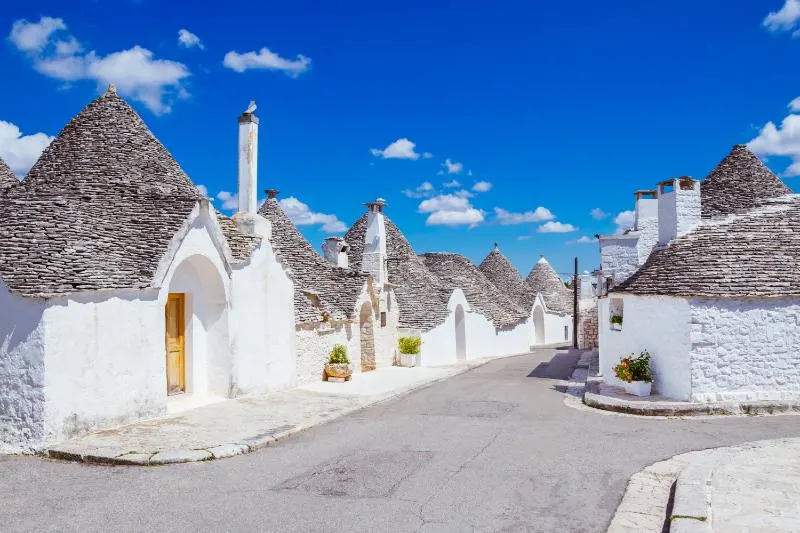
In the heart of Puglia, the Trulli of Alberobello stand as a testament to a unique architectural tradition dating back to the 14th century. Imagine a collection of whimsical stone huts, with their pointed roofs piercing the Italian sky like spires.
- Construction: Cleverly constructed without mortar, their conical roofs are feats of traditional engineering, using flat stones called ‘chiancarelle’.
- Material: Limestone, abundant in the region, forms the robust walls of these huts.
- Designation: In 1996, UNESCO recognized their cultural importance, listing them as a World Heritage Site.
- Today’s Use: While exploring, you’ll find some trulli transformed into cozy accommodations, quaint shops, and spots for a delightful meal.
These structures aren’t just a sight to behold; they offer a peek into the soul of southern Italy. Indulge in the local lore, find trulli souvenirs, and enjoy Apulian hospitality wrapped in the walls of history.
32. Island of Procida
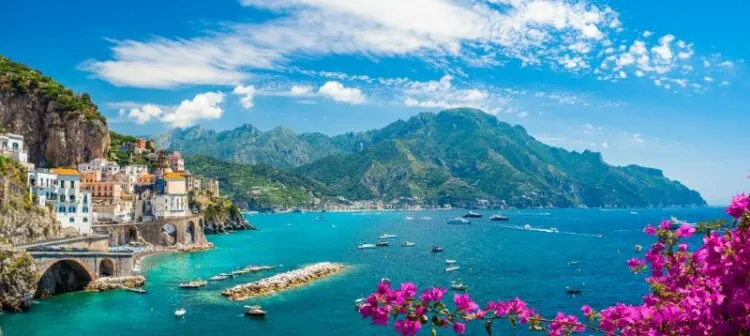
Procida, nestled in the heart of Campania’s azure waters, paints a vibrant tableau with its mosaic of multihued abodes and quaint fishing harbors. As you amble through the mazy, cobblestone streets, you’ll feel the island’s pulse—a quieter rhythm, far removed from the bustle of the Amalfi Coast.
Key Highlights:
- Endulge in exquisite marine fare, celebrated for its freshness and culinary craftsmanship.
- Immerse yourself in local traditions through the colorful spectacles of the Festa di Sant’Antonio Abate and the Festa di Santa Maria delle Grazie.
- Absorb the quiet beauty of the landscape, a sharp contrast to its lively celebrations.
Getting There:
- Ferries from Naples, Ischia, and the Amalfi Coast provide convenient access to Procida’s shores.
Discover Procida, your tranquil haven amid the sea’s embrace, where every corner offers a new secret to unveil.
31. Ponte Vecchio in Florence
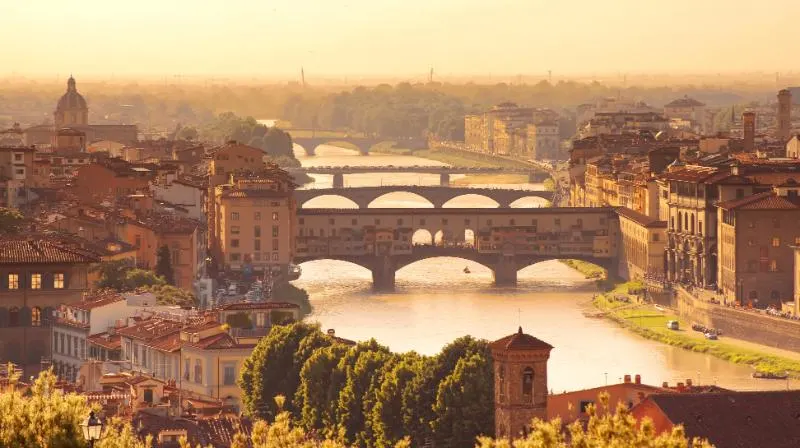
The Ponte Vecchio stretches across the Arno with enduring grace. This timeless bridge, a tapestry of Medieval craftsmanship, carries not just the footfall of its visitors but centuries of stories. Along its passage, a collection of boutiques offer the glitter of gold and premium wares, a nod to a legacy of trade etched deep into the stone since the 1300s.
As a living monument to Florence’s storied past, the bridge holds a unique distinction: it stood unyielding during the German withdrawal in the Second World War, a testament to the city’s unassailable spirit. Today, it’s not just a bygone relic but a vibrant artery of life and commerce.
As you mingle with the crowd and navigate through the bustling corridor, pause to soak in the riverside views – a beloved vista that captures the essence of Florence’s romantic heart.
- Travel Tip: Venture to the bridge at dusk. The sinking sun casts a golden hue over the Arno, transforming the waters into a painter’s dream.
- Local Secret: For an exclusive touch of Florence, explore the hidden jeweler’s workshops tucked away from the main path, where artisanal treasures await the discerning eye.
30. Verona Arena
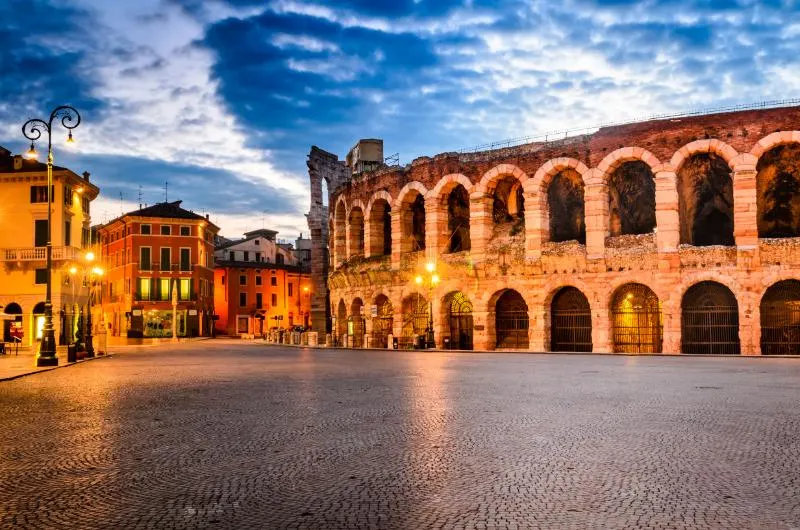
Step into the heart of Verona where echoes of ancient gladiators intertwine with the soulful arias of opera singers. The Verona Arena, a monument of architectural mastery, has stood the test of time for two millennia. Once a stage for grand Roman spectacles, it was a sight to behold with more than 30,000 fervent onlookers.
Key Highlights:
- Ancient Marvel: Built in the 1st century, this amphitheater is a testament to Roman engineering brilliance.
- Cultural Giant: Today, it ranks among the world’s largest venues for open-air opera.
- Musical Heritage: The stone walls have heard the stirring melodies of Aida and La Traviata, enveloping audiences in a rich tapestry of sound and emotion.
- Vibrant Surroundings: Nestled amidst cosy eateries and quaint shops, the ambiance around the arena buzzes with life.
Experience a performance here and you’re partaking in a centuries-old tradition, one that continues to beat at the very heart of Veronese culture. Remember to venture around as dusk falls, the golden lights painting an unforgettable scene, and let yourself be swept away by the vibrant night-life that pulses around this iconic structure.
29. Herculaneum
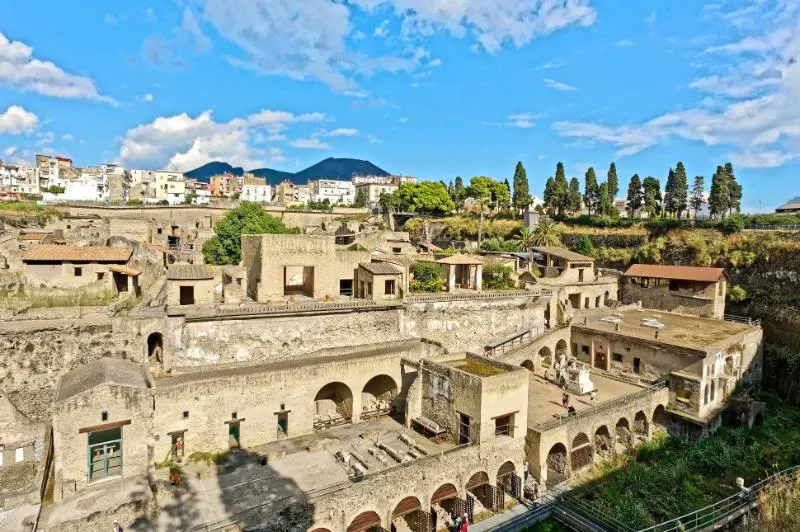
Imagine wandering through a smaller, yet exceptional sister to Pompeii, where the ancient Roman way of life is exquisitely encapsulated. In 79 AD, Mount Vesuvius unleashed its fury on Herculaneum, preserving its grandeur under volcanic ash and pumice, a tomb and treasure chest all at once.
Despite its quaint size, what you’ll walk through is a town astonishingly preserved. Your footsteps will echo on the stones of time as you stroll by vibrant frescoes and into homes where you can almost hear the whispers of the past. Marvel at the mastery of Roman engineering in their concrete work and ingenious water resistance techniques that have withstood time’s test.
Within the compact expanse of Herculaneum, a theatre, stunning thermal baths, and lively public squares await your discovery. And don’t just gaze at the structures—peer into the ancient shops, like little secrets hiding plain in sight, each with a story to tell.
Travel Tips:
- Allocate a few hours; this site is thorough yet manageable.
- Seek the hidden corners: some frescoes are in remarkably vivid conditions, sheltered from light and human touch for ages.
- Early mornings or late afternoons tend to offer cooler air and thinner crowds, perfect for reflective exploration.
28. Elba
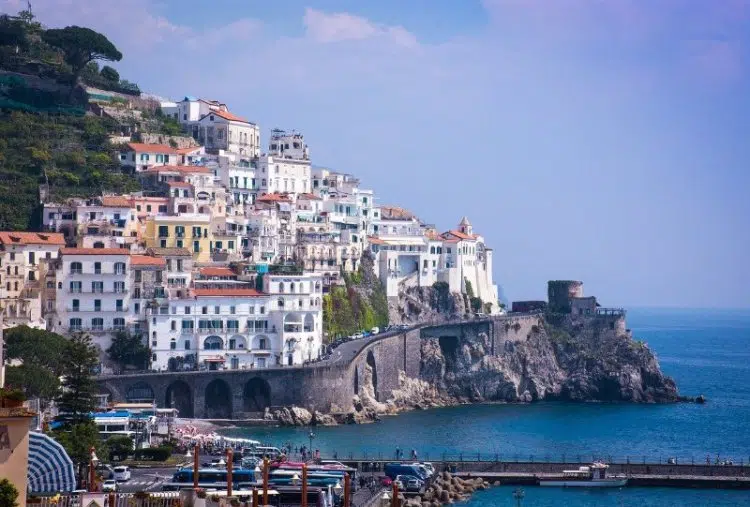
Nestled in the Tyrrhenian Sea, just a ferry ride away from the Tuscan coast, Elba stands as the largest gem of the Tuscan Archipelago. Imagine walking the same paths as Napoleon, exiled here in 1814, whose residences now welcome visitors from around the globe.
- Historic Sites: Tour Napoleon’s former abodes, winter and summer, reflecting his profound influence during a brief island tenure.
- Landscape: Immerse yourself in the island’s beauty, from idyllic beaches with translucent waters to verdant hills adorned with vineyards and olive groves.
- Medieval Towns: Traverse time in charming medieval settlements, perfect for culture enthusiasts yearning to experience living history.
- Activities: Embrace the call of the outdoors with an array of activities like hiking, cycling, and a spectrum of water sports.
Your palate will thank you for indulging in the local flavors, where seafood reigns supreme, complemented by exquisite olive oil. Elba doesn’t just invite visitors; it seduces them into a world where history, nature, and taste converge in perfect harmony.
See Related: Best Day Trips from Sorrento, Italy: Nearby Destinations
27. Grandeur of Gran Paradiso
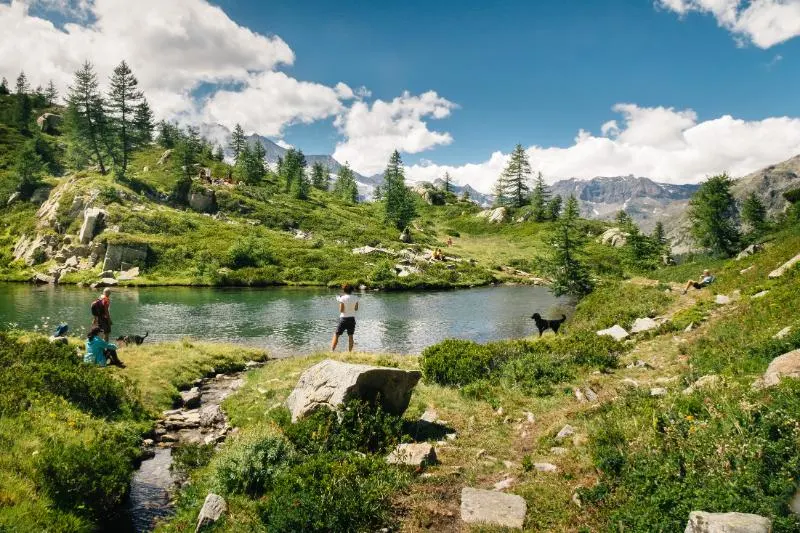
Nestled amidst the Graian Alps, the Gran Paradiso National Park lures with its pristine mountain vistas and a haven for trekkers. Initially a sanctuary to shield the local ibex herds, the park has become a biodiversity stronghold hosting wolves, lynx, ermine, and an impressive roster of over 100 bird species.
Accessible by car from neighboring hamlets, here’s where each season casts a spell. Summer brightens paths for hikers, autumn’s tapestry enchants, winter’s snow whispers to cross-country skiers, and spring blossoms into a photographer’s palette.
Highlights in Gran Paradiso:
- Gran Paradiso Peak: Not only a challenge for climbers but the apex that gifts you with Italy’s soul-stirring panoramas.
- Wildlife Spotting: Keep your eyes peeled for the regal ibex and other alpine creatures.
- Seasonal Activities: From hiking to skiing, the park is a year-round jewel.
26. Urbino’s Renaissance Masterpiece: The Ducal Palace
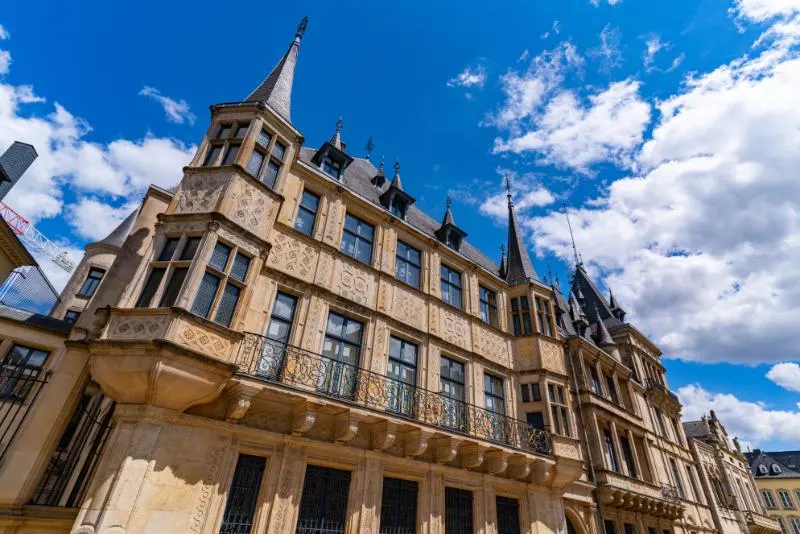
Immerse yourself in the splendor of the 15th-century Ducal Palace of Urbino, a renaissance gem nestled in the heart of the Marche region. Imagined by the visionary architect Luciano Laurana, this grandiose residence once housed the Duke of Urbino.
Below are facets of this architectural marvel:
- Courtyard: A harmonious central space embraced by elegant arcades
- Grand Staircase: A regal ascent framed within the building’s fabric
- Loggias & Balconies: Spectacular outdoor areas offering views and grandeur
Within these historic walls, you’ll encounter a treasure trove of artistic mastery featuring works from Piero della Francesca to Raphael, who left a tangible legacy within these corridors.
Visiting Tips:
- Open Hours: Grasp the essence of Renaissance life from 8:30 AM to 6:15 PM.
- Duration: Allocate 1-2 hours to fully savor the experience.
- Contact: Check ahead for any changes to opening times or exhibitions.
25. The Majesty of Rome’s Trevi Fountain

Your journey through Rome leads you to the grand spectacle of the Trevi Fountain, an enduring symbol of baroque artistry where water and sculpture blend with legend. Designed by Nicola Salvi and completed in 1762, this masterpiece features the sea god Neptune in a chariot drawn by seahorses, amidst an oceanic showdown.
Bask in the tradition here:
- Coin Tossing: Cast a coin, ensure your return to Rome; a second coin may just spark a Roman romance.
- Evening Splendor: As dusk settles, witness a transformation as lights illuminate the cascading waters, carving out a dream-like ambiance for evening admirers.
- Romantic Engagements: The intimate glow of the lit fountain in the night makes it a prime spot for heartfelt marriage proposals.
Travel Tips:
- Best Viewpoints: Aim for early morning or very late evening to evade the crowds.
- Stay Nearby: Seek accommodation in the surrounding area to enjoy the fountain’s charm at your leisure.
Remember, this isn’t merely a fountain; it’s an opera of stone and water, and each visit writes a unique verse in its enduring sonnet.
24. The Splendor of Santa Maria delle Grazie in Milan
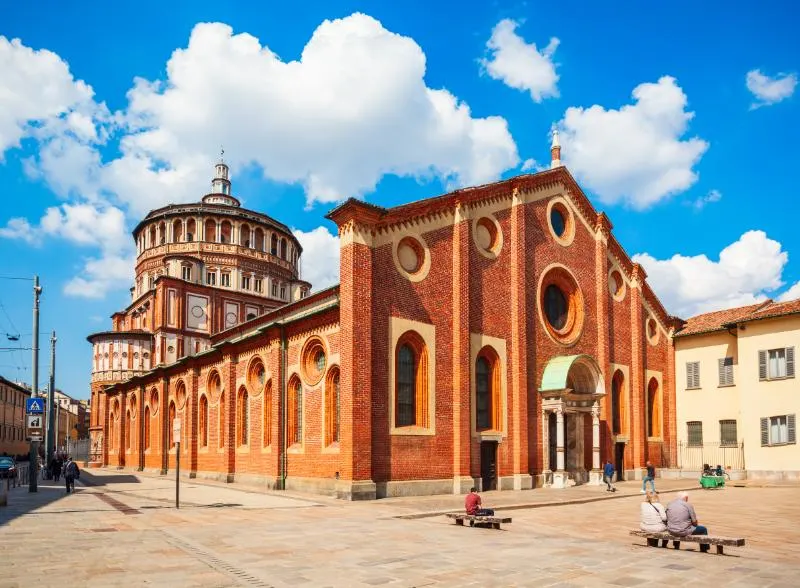
Steeped in history, the illustrious Santa Maria delle Grazie stands proudly in the heart of Milan, a testament to Italian Renaissance brilliance. Constructed in the 15th century, this church and its adjoining Dominican convent are revered for sheltering one of humanity’s most magnificent artistic achievements—Leonardo da Vinci’s “The Last Supper.”
Key Highlights:
- Artistic Marvel: Within these venerable walls, you’ll find the renowned refectory that houses “The Last Supper,” a narrative masterpiece encapsulating the pivotal moment of revelation by Jesus to his apostles.
- World Heritage Status: Recognized by UNESCO, the site preserves not just the painting, but also the architectural and historical essence of the period.
Visitor Tips:
- Best Times to Visit: Forge a plan to arrive early morning or late afternoon to dodge the swelling throngs of art aficionados.
- Exploration Encouraged: Revel in the ambiance of this sacred space and meander through the entrancing church grounds.
To truly bask in the church’s splendor without the rush, consider lodging in Milan’s various quarters, each offering its own charm. They serve as the perfect retreat after a day spent wandering through time in the company of da Vinci’s genius.
See Related: Churches That Help with Motel Vouchers for the Homeless: Providing Support and Assistance
23. La Pelosa
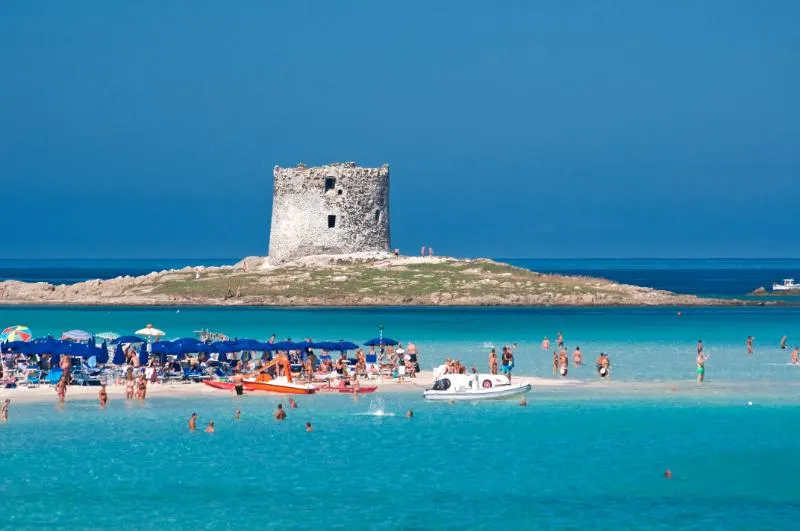
Nestled on Sardinia’s western frontier, you’ll discover the serenity of La Pelosa. Renowned for its powdery beaches and ankle to knee-deep turquoise seas, the transparency here rivals the crystalline Caribbean waters.
Notable Highlights:
- Crystal-clear sea allowing visibility straight to the seabed
- Fine sandy shores beckoning for leisurely strolls
- Activities: Surfing, kayaking, scuba diving
While there, indulge in water sports that dot the shoreline, from playful surfing to introspective kayaking. Dive below the shallow surface where sub-aquatic scapes unfold for an intrepid traveler. Remember, although La Pelosa’s views are boundless, the best experiences are those savored without hurry, much like Sardinia’s own pace.
22. Ravenna’s Mosaic Marvel: The Basilica of San Vitale
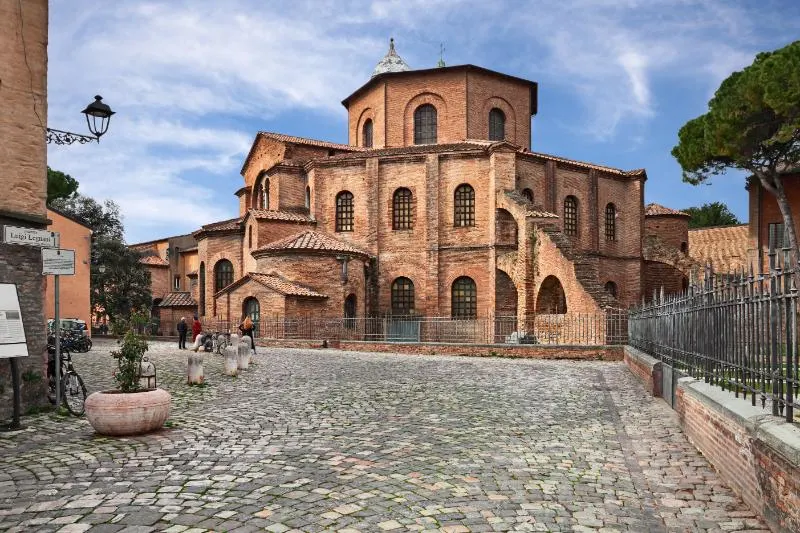
Step into the Basilica of San Vitale and you’re stepping back into the 6th century. This church, a masterpiece of Byzantine brilliance, captivates with mosaics that make the walls, domes, and floors come alive with biblical tableaus.
Key Highlights:
- Unique Design: Unlike many early Christian churches, the basilica boasts a circular layout, a nod to the innovative spirit of the age.
- Dome Grandeur: The dome rises majestically, a central feature that captures gazes and hearts alike.
- Mosaic Mastery: Revel in the biblical stories vibrantly portrayed through the mosaic art that lines the interior.
- UNESCO Recognition: This site has earned its UNESCO World Heritage status, a badge of its historical and cultural splendor.
To absorb its full historical tapestry, consider a guided tour. Here, you can immerse yourself in its narrative underpinned by expertise and reverence.
21. Dolomites
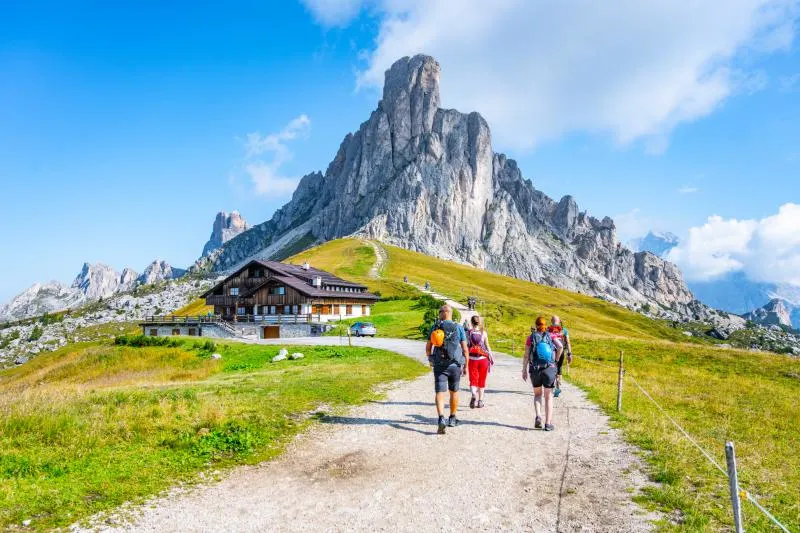
Nestled in Italy’s northern peaks, the Dolomites are a tapestry of sheer cliffs and bold rock formations, bathed in a warm, amber glow. This UNESCO-listed range invites you, the nature aficionado, to indulge in the great outdoors.
- Hiking & Climbing: Navigate trails weaving through alpine meadows to rugged summits.
- Winter Sports: Carve through crisp snow on skis or a board in the colder months.
- Cycling: Tackle the mountain passes with a bike, embraced by fresh, high-altitude air.
- Lakes & Valleys: Gaze upon tranquil lakes, encased by the mountain’s grandeur.
- Historic Villages: Soak in local traditions in hamlets like Castelrotto and Cortina d’Ampezzo.
With every step, the Dolomites promise an authentic slice of Italian alpine charm, a symphony of activities set against a backdrop that commands awe and reverence.
20. The Twin Churches of Saint Francis in Assisi
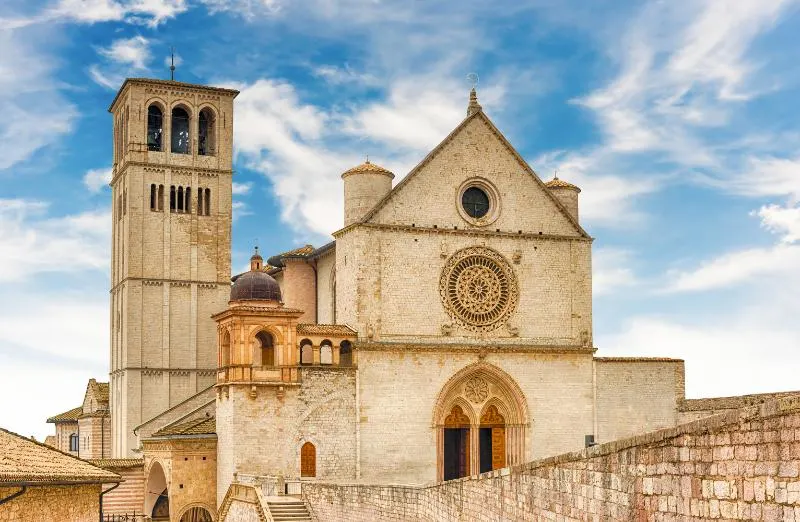
Immerse yourself in the hushed echoes of history as you explore the Basilica di San Francesco, a sacred tribute to the humble Saint Francis. This astounding edifice bears the weight of the 13th century, its dual layers holding tales of artistry and devotion.
- Upper Church: Ascend to find a realm adorned with frescoes by Renaissance virtuosos such as Giotto and Lorenzetti. Each brushstroke narrates biblical stories and St. Francis’ earthly journey.
- Lower Church: Beneath, simplicity weaves through the air, a stark, yet elegant contrast to the imposing grandeur above.
Peer closer at the crypt, where artistry collides with the sacred—stained glass windows, detailed chisel work, and a patchwork of historic art pieces can be found.
Travel tip: Time your visit to catch the soft glow of morning light, accentuating the divine artistry of the Upper Church’s frescoes. Seek out the less traversed nooks of the Lower Church to truly appreciate its restrained elegance, reminiscent of the saint it venerates.
19. Sassi di Matera
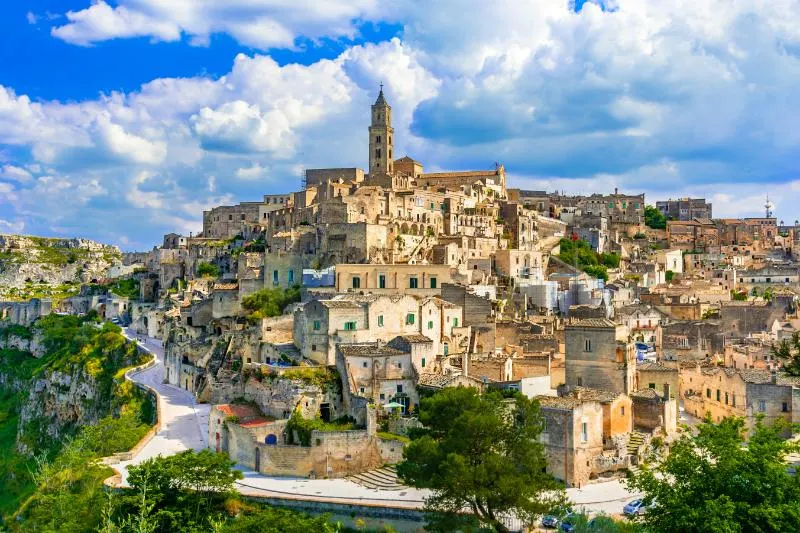
Matera boasts a labyrinth of prehistoric cave abodes, known as the Sassi di Matera. Engraved directly into the calcareous rock face, these venerable habitats trace back nearly 9 millennia, standing as Italy’s most ancient settlement.
Remarkable Facts:
- Ages of habitation: Up to 9,000 years
- Unique features: Integral cave dwellings
- Contemporary use: Homes, shops, eateries
Exploring these Sassi, you saunter through layers of times past and then, within steps, indulge in the area’s finest wines within a cave-turned-vinoteca, mirroring those ancestral hollows.
18. Mount Etna
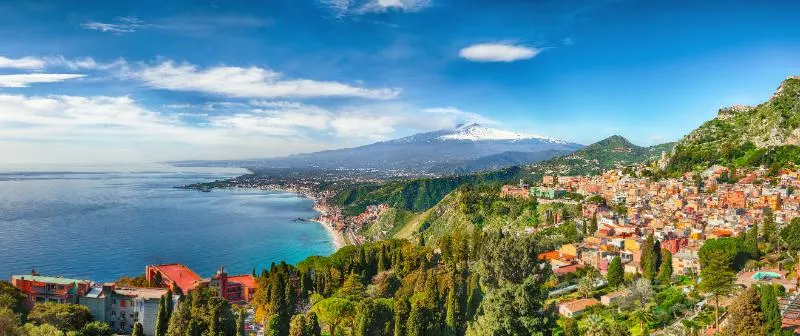
Often cloaked in a shroud of mist and steam, Mount Etna stands as a magnificent beacon on Sicily’s eastern horizon. This formidable natural wonder not only boasts the title of the highest active volcano in Europe but also serves as a centerpiece in Sicily’s panoramic vistas.
- Height: Approximately 3,329 meters
- Location: East coast of Sicily within Parco dell’Etna
- Activity: Frequent eruptions, sometimes multiple per year
Renowned for its constant state of activity, Etna provides a rare opportunity for adventure seekers to explore its rugged landscapes. Traverse craters and fissures that narrate Earth’s fiery underground tales. The brave at heart can witness viscous lava flows or vaporous vents, hinting at the mountain’s relentless inner churn.
In the midst of this primordial scenery lies a delightful paradox: the fertile volcanic soil generously gifts the region with exquisite vineyards. Your palate will thank you for indulging in the local wines, each glass echoing the essence of Etna’s terroir.
Remember, a visit to Mount Etna is not merely a tick on a travel list; it’s a thrilling encounter with one of nature’s most powerful forces and a testament to life’s resilience amidst it.
17. Cathedral of Orvieto’s Allure
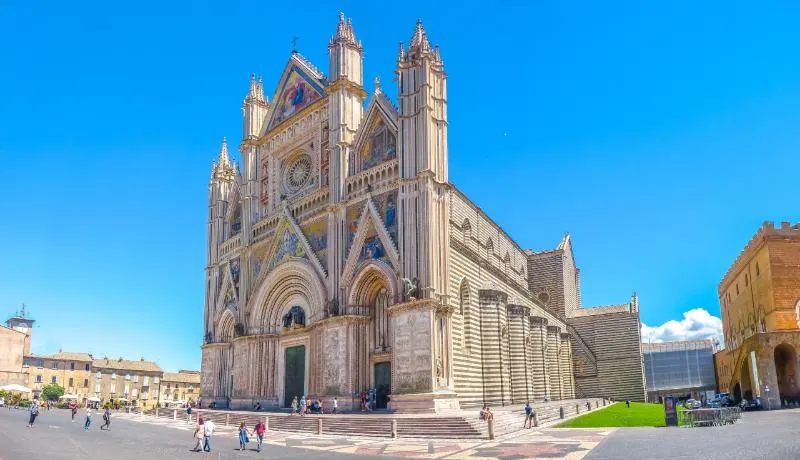
Nestled in the heart of Italy, the Cathedral of Orvieto stands as a captivating monument to medieval Gothic architecture. Constructed in the 13th century, its façade astounds with a tapestry of biblical narratives, and intricate stone fretwork that pays homage to saints and symbolic figures.
Façade Glory
- Biblical carvings
- Stone mosaics
- Saints and allegories
The interior holds its own with arresting frescoes by Luca Signorelli, unfolding apocalyptic visions and celestial tales. This artistry serves as more than mere decoration; it’s a chronicle of past faith and Orvieto’s storied legacy.
What’s Inside
- Signorelli’s frescoes
- Tales from Revelation
Your visit will resonate with the sense of awe that has gripped pilgrims and art lovers alike. Feel the weight of history in the cool, echoing naves and let the stories etched in stone and paint transport you.
See Related: Best Bus Tours in Italy
16. Pizza Napoletana

In Naples, a city heralded for its culinary heritage, the pizza reigns supreme. Here, tradition is folded within the dough, creating pizzas with an ephemeral crust and robust sauce. Adhering to the illustrious “Vera Pizza Napoletana” standard, certain pizzerias showcase an authenticity verified by The Naples Pizza Association.
Top Tips:
- Savor the Pie: Indulge in a full pie by yourself, as local custom dictates.
- Certified Flavors: Seek out the “Vera Pizza Napoletana” seal for an authentic taste.
- Local Delicacies: Don’t miss Naples classics – the marinara and margherita.
Remember: When in Naples, dining on pizza isn’t just a meal—it’s an essential experience.
15. Portofino
Portofino drapes its elegance along the Italian Riviera, a tapestry of homes ascending from its iconic harbor—each a splash of color against the deep green of Mediterranean pines. A mere whisper away from Genoa, this once humble fishing village now beckons as a serene escape.
- Stroll and Discover: Navigate the breezy coastal paths or meander through the town center.
- Historic Landmarks: Marvel at the Castello Brown, a sentinel since the 16th century, or find solace in the ancient walls of St. Martin’s Church.
- Indulge in Local Delights: Savor Italian delicacies, complemented by the region’s crisp Pinot Grigios.
- Unique Finds: Peruse the glass jewelry that encapsulates the spirit of Liguria.
Immerse yourself in the unhurried rhythm that has charmed visitors through the ages, finding joy in the simple pleasures of Portofino living.
14. St. Mark’s Basilica in Venice
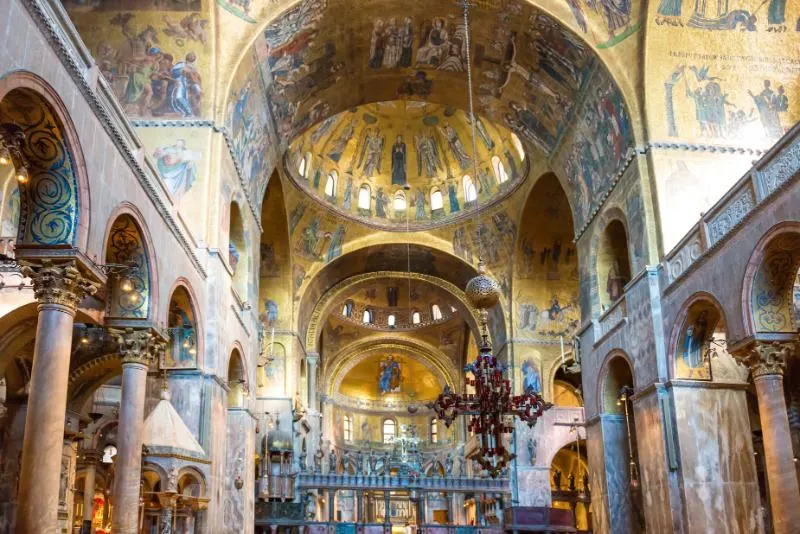
Amid the buzz of Piazza San Marco, you’ll discover Basilica di San Marco, more than a marvel in architecture—it is a treasure trove from the Venetian epoch. Erected in the 11th century, the basilica captivates with over 500 pillars supporting its frame, prismatic domes that grace the skyline, and Byzantine mosaics shimmering with gold.
- Bronze Horses: Gaze upon the Bronze Horses that guard the thresholds, their history lost in time yet their presence commanding.
- Treasury & Museo Marciano: Venture within to uncover a world of opulence – the treasury brims with historic riches, from precious jewels to intricate tapestries.
Remember, as you step onto the hallowed grounds, to dress with respect—shoulders and knees under wraps—honoring the sanctity of this storied basilica.
13. Capri
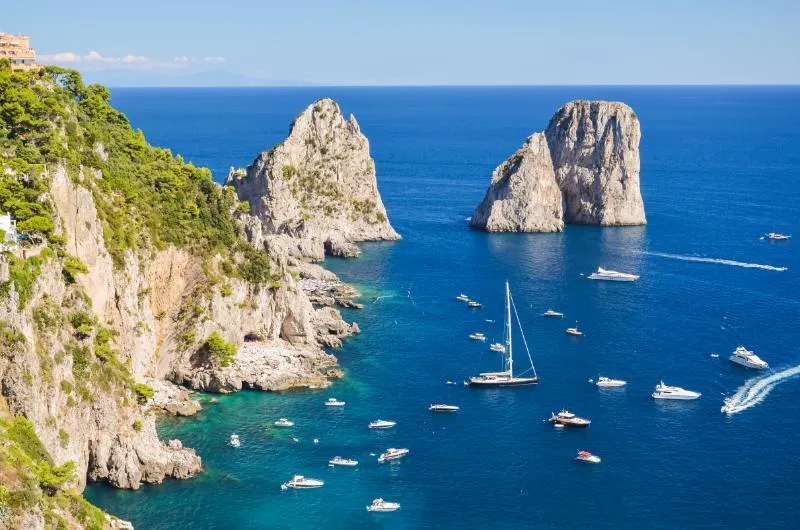
Capri captivates with its dramatic coastal cliffs and the azure embrace of the surrounding sea. Your wanderlust is rewarded by encounters with the opulent Villa Jovis, once home to Emperor Tiberius, whispering tales of ancient luxuries. Emerge into the ethereal glow of the Blue Grotto, a sea cavern where sunlight dances through water to paint everything in sapphire hues.
Stroll Capri’s heart at the Piazzetta, a quaint square fringed by cozy cafés and alluring boutiques, ideal for moments of leisurely respite. Embrace outdoor endeavors as you dive into crystalline waters or navigate Capri’s network of trails that promises unrivaled vistas at every turn.
- Sightseeing Highlights:
- Villa Jovis: Historical immersion
- Blue Grotto: Natural light spectacle
- Piazzetta: Central social hub
Immerse yourself in Capri, where the essence of a grandiose past meets the thrill of present exploration.
12. St. Peter’s Basilica in Rome

As you wander through the heart of the Vatican, the grandeur of St. Peter’s Basilica unfolds before you—a true architectural marvel. This illustrious sanctuary not only embodies the essence of the Catholic faith but also stands as a testament to the artistry of the Renaissance and Baroque eras.
Bearing the name of St. Peter, one of the primary followers of Jesus, the basilica is believed to enshrine his remains beneath its majestic altar. The synthesis of Bramante’s initial vision, Michelangelo’s ingenuity in sculptural elements, and the final touches by Bernini, coalesce into the basilica’s iconic dome that defines the Roman skyline.
Despite its religious significance, St. Peter’s Basilica transcends spiritual bounds, inviting all to behold its artistry. Within these hallowed walls, you’ll encounter Michelangelo’s poignant Pieta and gaze upwards at the ornate dome, its celestial scale a marvel to comprehend.
Visitor Information:
- Mass Schedule: Attendees are welcomed for Mass; check times in advance.
- Art Highlights: Michelangelo’s sculptures and the dome interior.
- Architecture: A blend of Renaissance and Baroque styles.
- Accessibility: The immense size accommodates all visitors, symbolic of a space shuttle with its boosters.
Absorb the sheer scale and beauty; this isn’t merely a sacred site, but also a cultural treasure trove that captures a universal narrative far beyond its papal ties.
11. Valley of the Temples
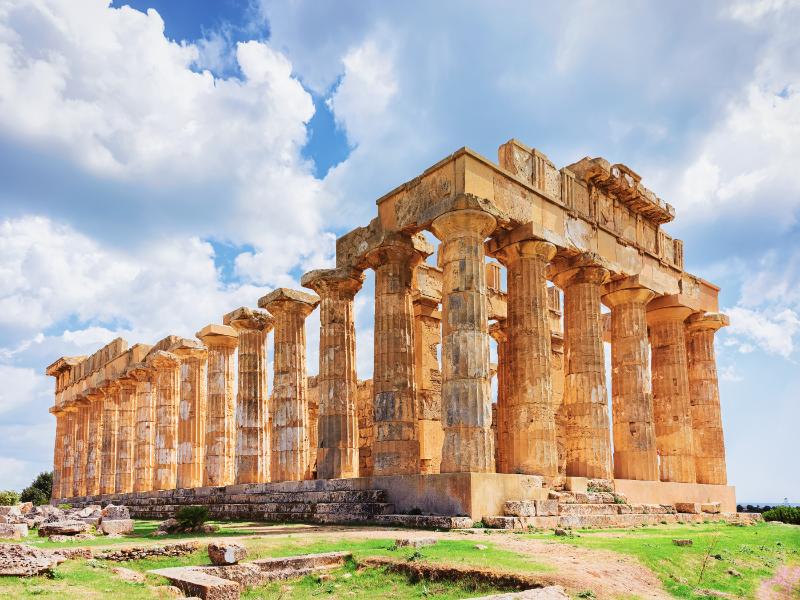
Nestled in the heart of Agrigento, Sicily, the Valley of the Temples stands as a testament to ancient grandeur. Imagine strolling amongst the still-standing Doric columns of the Temple of Hera, a place once bustling with worshippers. A short walk away, the Temple of Concordia commands attention, its archaic structure ranked among the best preserved in the world.
- Temple of Hera (Juno): Embrace the panoramic views.
- Temple of Concordia: Marvel at the age-defying structure.
- Temple of Heracles (Hercules): Reflect on myths of might and wit.
UNESCO Heritage Status: A mark of its unparalleled significance.
Tip: Visit during golden hour for a breathtaking spectacle as the sun graces ancient stones with a warm glow. Discover these majestic ruins and let the whispers of history envelop you.
10. San Gimignano
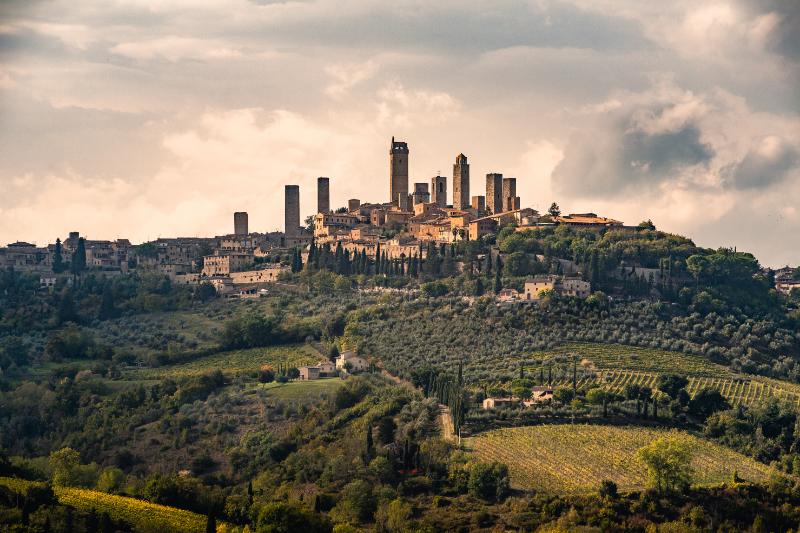
Nestled within the rolling Tuscan hills, San Gimignano rises with a silent yet imposing presence. You’ll find preserved medieval architecture personified in its 14 enduring towers, monuments to the town’s historic affluence and might.
- Medieval Towers: Once numbering over 70, they served as bastions against invaders.
- Historical Preservation: The calamity of the Black Death left the town untouched by further conflict, aiding the conservation of its towers.
- Accessibility: A stone’s throw away from both Florence and Siena.
- Culinary Delight: Home to Vernaccia di San Gimignano, a crisp, esteemed white wine.
- Lively Festivities: A calendar filled with vibrant events that animate the town throughout the year.
As you meander through the ancient streets, sip on the local Vernaccia, an elixir capturing the essence of the sun-kissed Tuscan vines. The town’s towers, each whispering tales of the bygone era, beckon you to explore and create your narrative within their storied shadows.
9. Manarola
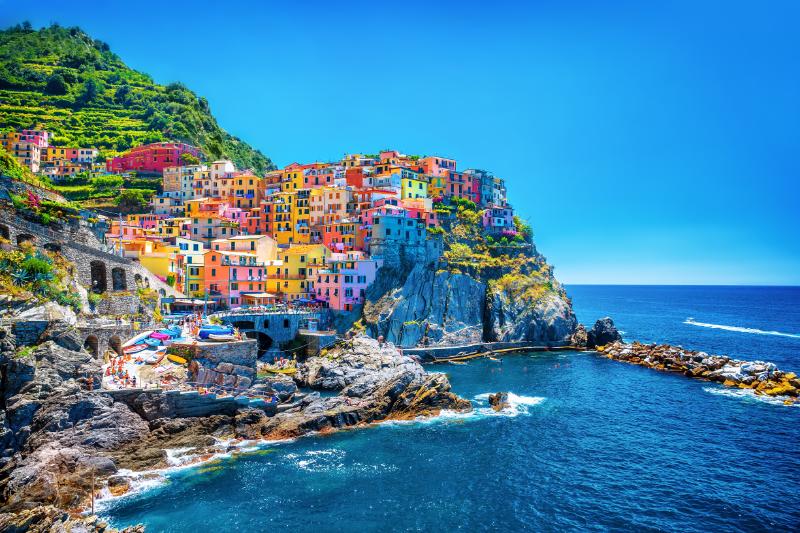
Nestled in La Spezia’s embrace, Manarola is a jewel amongst the treasured Cinque Terre, a coastal quintet that exudes vibrancy. Imagine yourself weaving through the cobbled streets, lined with a kaleidoscope of houses that defy gravity on the rugged cliffs. The Ligurian Sea whispers tales of yore, inviting you to capture its splendor through lens or brushstroke.
Your spirit for adventure beckons you to explore the craggy paths, perhaps partaking in a hike that serves up panoramic vistas, or maybe a boat excursion that allows for a unique perspective of this seaside haven. Culinary delights await in cozy eateries, promising your palate a taste of Liguria’s finest flavors.
Convenient rail connectivity spares you the walk on the Cinque Terre trail, ushering you directly into the heart of Manarola. Embrace the simplicity of travel here, where the train rhythm resonates with the pulse of local life.
- Access: A train links Manarola with its sister towns.
- Gastronomy: Local cafes and restaurants offer regional specialties.
- Activities: Opt for captivating hikes or serene boat tours.
8. Leaning Pillar of Pisa
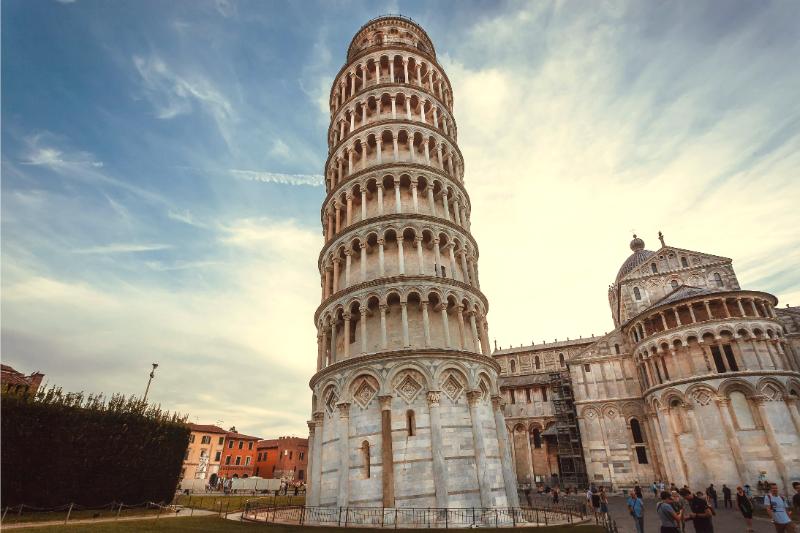
Experience the allure of Tuscany through the iconic tilt of Pisa’s monument. Conceived in the 12th century, your journey up its spiraling staircase — all 296 steps — rewards you with views that span centuries.
Despite an initial setback due to the unstable groundwork, the tower stands as a testament to ingenuity; its construction saw a hiatus, a strategic comeback, and finally completion in the 14th century. An architectural marvel, this structure beckons you to ascend, as it did in 2001, sharing its storied lean with every traveler who braves the climb.
7. Lake Como
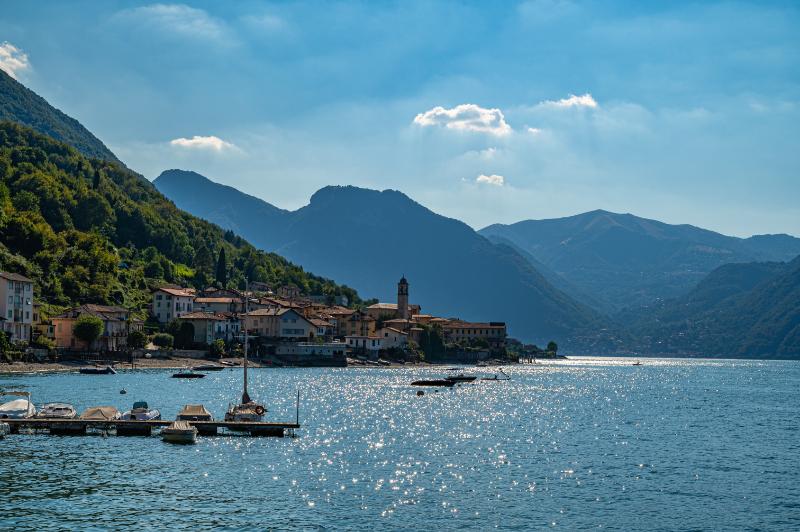
Nestled within Italy’s scenic Lake District, Lake Como beckons with its pristine air, glistening waters, and year-round pleasant climes that have enthralled travelers for over a century.
Geography:
- Form: Resembling an inverted ‘Y’
- Branches: Commence at Como and Lecco, uniting northward
- Terminus: Culminates at Colico
Attractions:
- Villas: Historical, dating back to Roman eras
- Gardens: Lush with tropical and temperate flora
Your exploration might begin where the lake’s arms embrace, travelling from the vibrant towns of Como or Lecco to the tranquil reaches toward Colico. Each step is an opportunity to witness storied villas surrounded by botanical wonders, a testament to their enduring allure from antiquity to present.
6. Positano
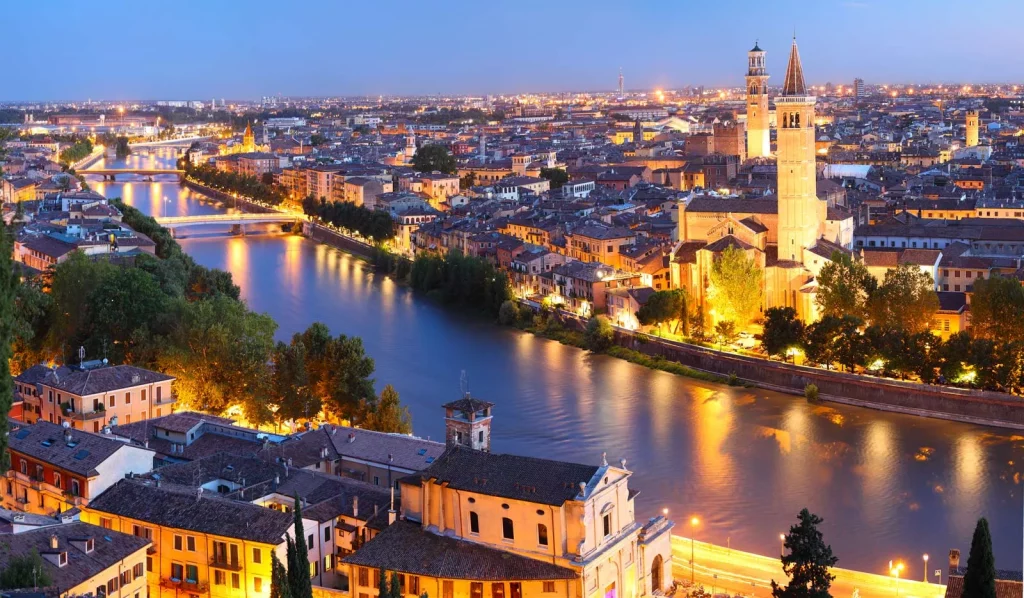
Nestled on the Amalfi Coast’s cliff edges, Positano cascades with grace to the sea. Medieval prosperity once bloomed here, though by the 1800s, it dwindled. The pen of John Steinbeck repainted Positano as an enchanting getaway.
- Historical Transformation: A quaint fishing village turned jet-setter haven.
- Architectural Marvel: Buildings perch precariously yet harmoniously on steep slopes.
- Must-Visits: Chiesa di Santa Maria Assunta for spiritual heritage; secluded Spiaggia del Fornillo beach for tranquillity; Spiaggia Grande for its vibrant seaside buzz.
- Insider Tips: Seek out Montepertuso for romance away from the crowd; early mornings offer serenity against the typical bustle.
5. Pompeii

Nestled near the vibrant city of Naples, the eternal town of Pompeii offers a remarkable voyage back to ancient Roman times. Entombed by Mount Vesuvius’s unforgiving eruption, the city is a trove of archaeological wonders, with its cobblestone streets and timeworn edifices standing as a testament to its former splendor. Highlights include:
- The Forum: Once the heartbeat of Pompeiian society, now an open-air gallery of antiquity
- Sacred Temples: Devotional sites that echo the spiritual life of a bygone era
- Bathhouses: Imposing structures showcasing Roman engineering and social life
- Private Dwellings: Explore residences adorned with intricate frescoes and mosaics
In touring Pompeii, prepare for the Mediterranean climate. Bring an umbrella to shield from sudden showers, and don a hat to ward off the sun’s zealous rays.
4. Siena’s Iconic Civic Plaza
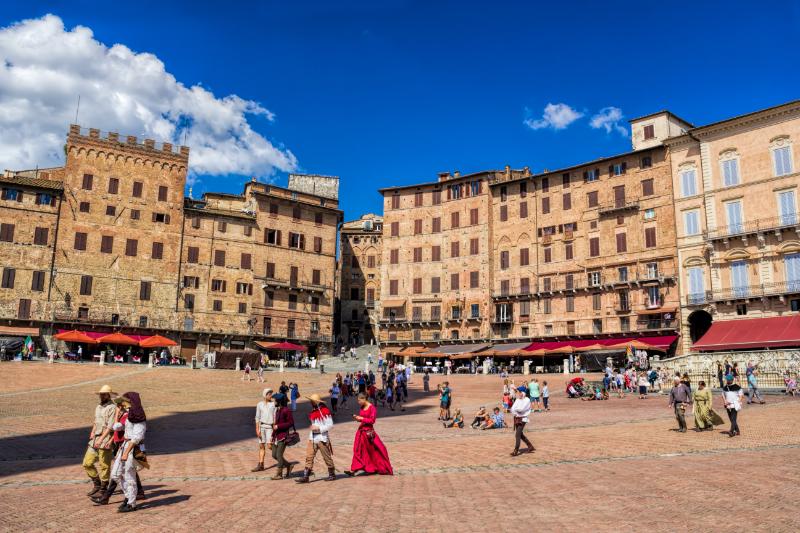
Nestled at the heart of Siena’s UNESCO-designated historic center, Piazza del Campo stands out as a stunning testament to medieval urban planning. Its unique shell form, embraced by imposing structures like the Palazzo Pubblico and its grand tower, sets the stage for an evocative Italian tableau.
- Iconic shaped as a seashell; a hallmark of Siena
- Palazzo Pubblico: Majestic municipal palace
- Towering presence: The tower symbolizes Siena’s rich past
- Palazzi signorili: Echo the affluence of ancient families
The piazza echoes with thundering hooves during the electrifying Palio di Siena, a traditional horse race steeped in local color and competitive spirit. This brief yet intense spectacle transforms the plaza, with a specially lain dirt track setting the scene for a passionate display of horsemanship that captures the essence of Sienese culture.
3. Florence’s Crown Jewel: The Cathedral of Santa Maria del Fiore
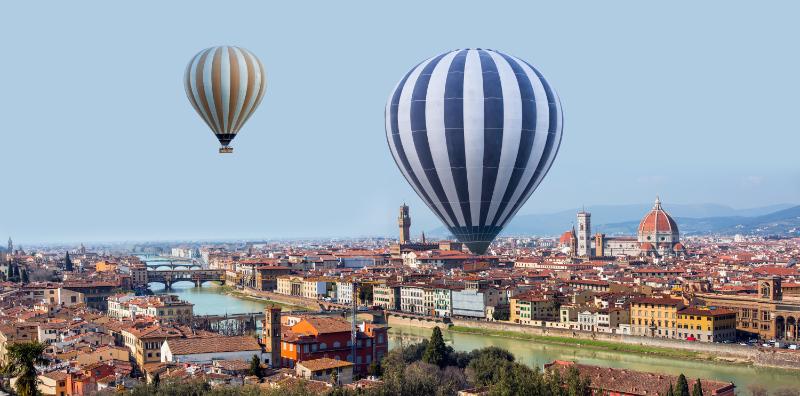
Florence’s Cathedral of Santa Maria del Fiore is majestically the city’s heart. The Duomo, renowned for its iconic presence, is a testament to the grandeur of Gothic architecture. It spans over a century, having been completed in 1436 with a consecration led by Pope Eugene IV.
The cathedral is enrobed in a pink and green marble facade, a vibrant testament to Florence’s creative spirit. Its crowning glory, Brunelleschi’s Dome, defied the engineering of its time and continues to command the city’s skyline as one of the largest domes on Earth.
The Duomo houses a vast nave adorned with intricate frescoes within its walls. Side chapels and a prominent high altar add to the cathedral’s splendor, making it an unmissable visit on your Florentine journey.
- Architecture: Gothic grandeur with a striking facade
- Dome: An engineering marvel by Filippo Brunelleschi
- Interior: Richly decorated with frescoes and a grand nave
As you walk the hallowed floors, feel the echo of history under the soft lighting that filters through stained glass, and let the Duomo’s timeless beauty envelop you.
See Related: How to Plan a Greece Itinerary to Maximize Your Trip
2. Grand Canal in Venice
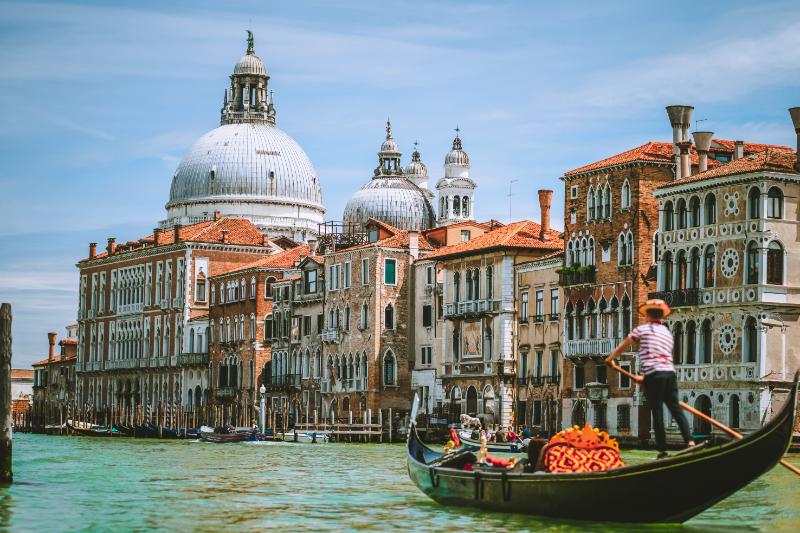
As Venice’s majestic thoroughfare, the Grand Canal is the city’s lifeline, weaving its history and beauty through its water-bound avenues. Your eyes can feast on the palatial facades that rise directly from the waters, a testament to the former wealth of this floating metropolis.
- Transport: Glide along in a vaporetto to drink in the splendor or choose a private water taxi for an intimate voyage.
- Highlights: Architectural marvels abound from the Rialto Bridge to the elegant bend near Santa Maria della Salute.
- Tips: For serene moments, seek a gondola at dusk when the water glistens with reflections of Venetian splendor.
Embrace the allure of Venice from its aquatic heart, where every turn tells a story and each ripple whispers of past glories.
1. Rome’s Iconic Amphitheater: The Colosseum

Stepping into the Colosseum, you are treading across the heart of historical grandeur, situated within Rome’s storied precincts. This architectural marvel, erected in 80 AD, once played host to the thrilling gladiatorial clashes and enthralling public spectacles of yesteryear. Here, up to 50,000 voices could once be heard, cheering in unison within its towering elliptical stands.
Despite the wear of time’s relentless passage—earthquakes, thievery, and the ravages of stone removal—the Colosseum’s bones have staunchly withstood, now proudly under UNESCO’s protective embrace. Today, whether you choose to wander its arches solo or embrace the depth of a guided tour, you’ll find yourself absorbed by its enduring legend.
Travel Tips:
- Best Time to Visit: Embrace the Colosseum’s shifting aura by arriving one hour pre-sunset for a spectacle starting in daylight, transitioning to twilight, and culminating under the stars.
- Visiting Hours & Tickets: Confirm the current opening times and entry fees, as they periodically change. A common ticket bundle often includes entry to neighboring ancient sites.
- Before You Go: Remember, strict security measures are in effect. Large bags and suitcases are a no-go, ensuring safe and smooth travels through ancient Rome’s byways.
Embark on this timeless journey through what could easily be the most storied of Italy’s treasures, and watch as history unfurls beneath your footsteps, laden with whispers of a bygone era.
Related Resources:
